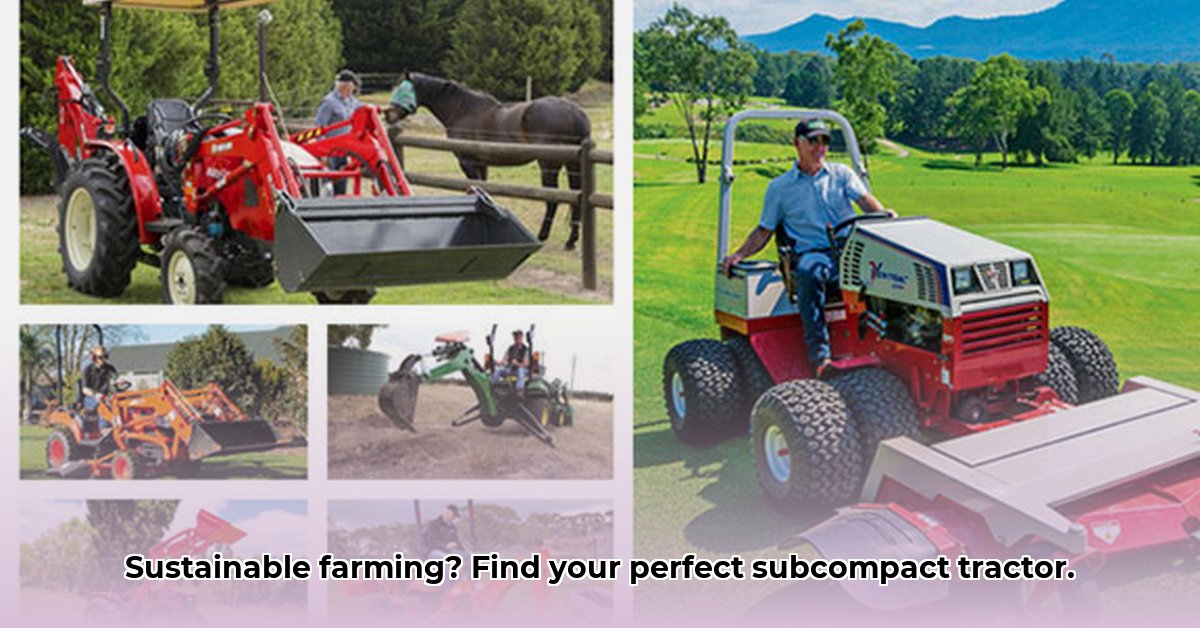
Finding the right subcompact tractor can significantly impact the success and sustainability of your farming operation. This comprehensive guide helps you navigate the market, comparing key features, costs, and sustainability implications to find the perfect fit for your needs. For more options, consider exploring rent-to-own options.
Key Factors to Consider for Sustainable Farming
Choosing a subcompact tractor requires careful consideration of several crucial factors. The right choice balances power, efficiency, and maneuverability within your budget and farming practices.
Horsepower (HP): This indicates the tractor's engine power. Higher HP enables heavier tasks like tilling, but increases fuel consumption and cost. Consider the intensity of your typical operations: A small orchard needs less HP than a larger vegetable farm.
Lift Capacity: This specifies the maximum weight the tractor's lift arms can handle. Ensure your chosen model can lift your intended implements (e.g., mowers, tillers). Higher lift capacity offers versatility but generally increases cost.
Fuel Efficiency: For sustainable farming, fuel efficiency is paramount. It directly impacts operating costs and reduces your carbon footprint. Look for tractors with advertised fuel economy figures from manufacturers or independent reviews. A fuel-efficient tractor can save considerable money over its lifespan.
Maneuverability: Subcompacts are designed for smaller spaces, but their maneuverability varies. Consider the size of your fields and the ease of navigation around obstacles. A tighter turning radius improves efficiency. Hydrostatic transmissions enhance maneuverability significantly.
Four-Wheel Drive (4WD): 4WD provides additional traction, especially crucial in wet or hilly conditions. While not essential for all farms, it enhances performance and safety in challenging terrains.
Transmission Type: Hydrostatic transmissions (HST) provide smooth, infinitely variable speed control, ideal for precise work and tight spaces. Manual transmissions are simpler but require more operator skill.
Sustainable Implement Compatibility: Check compatibility with implements promoting sustainable practices, such as no-till tools and precision seeding equipment. Ensure the tractor can effectively utilize your preferred farming techniques.
Comparative Analysis of Top Subcompact Tractor Models
The following table compares popular subcompact tractor models. Specifications may vary by model year, so always consult the manufacturer's website or your local dealer for the most up-to-date information. Prices are estimates and can vary widely based on location, dealer, and included options.
| Tractor Model | Manufacturer | Horsepower | Lift Capacity (lbs) | Hydrostatic Transmission | 4WD | Approximate Price Range ($) | Key Features |
|---|---|---|---|---|---|---|---|
| Kubota BX23S | Kubota | 23 | 1,543 | Yes | Yes | $18,000 - $22,000 | Excellent fuel efficiency, compact design |
| John Deere 1025R | John Deere | 25 | 1,800 | Yes | Yes | $20,000 - $25,000 | Reliable, wide range of attachments available |
| Mahindra 1526 | Mahindra | 26 | 1,700 | Yes | Yes | $16,000 - $20,000 | Often cited for its value; strong for its price point |
| Yanmar SA221 | Yanmar | 22 | 1,323 | Yes | Yes | $17,000 - $21,000 | Known for reliability and ease of maintenance |
Sustainability Considerations: Minimizing Environmental Impact
Subcompact tractors offer several advantages for sustainable farming. Their smaller size minimizes soil compaction compared to larger tractors, preserving soil health. Lower fuel consumption reduces both operating costs and greenhouse gas emissions. They lend themselves well to precision agriculture techniques, enabling efficient resource use. However, they may have limitations for extremely heavy tillage or very large fields.
"Choosing a subcompact tractor is a step towards responsible agriculture," says Dr. Emily Carter, Professor of Agricultural Engineering at the University of California, Davis. "Their reduced impact on soil structure and lower fuel consumption contribute directly to environmental sustainability."
Cost Analysis: Total Cost of Ownership
The total cost of ownership extends beyond the initial purchase price. Factor in fuel costs, routine maintenance (oil changes, filter replacements), potential repairs, and the cost of any necessary implements. While precise long-term cost comparisons are challenging without specific usage data, preventative maintenance significantly reduces unexpected repair expenses. A higher upfront cost might translate into lower operating costs over the tractor's lifespan.
Conclusion and Recommendations
Selecting the optimal subcompact tractor depends on your farm’s size, crop type, budget, and long-term sustainability goals.
- Small farms/hobby farms: A lower HP model with HST is suitable.
- Larger farms/diverse operations: A higher HP model with 4WD might be necessary.
Consult with other farmers, visit dealerships, and test-drive various models. Your local agricultural extension office can also provide valuable advice and resources. The best tractor empowers your sustainable farming practices and ensures a thriving and profitable harvest.